Hello and welcome to our review of TP-Link’s neat Archer AX10 device. When it comes to budget routers, we feel that this could be one of the best out there.
You might have thought that a router this low in cost would be a little slow. But that’s just not the case. We’ve been running plenty of tests to find out how good the AX10 is and we’re quite surprised by the results in a good way!
We’re also digging the fact that it comes with a bunch of cool extras such as beamforming and security, so don’t go anywhere as we look into all of those and more in our comprehensive review of the AX10.
Specifications
| Brand | TP-Link |
| Model | Archer AX10 |
| Max Tested Wi-Fi Speed | 651.97 Mbps |
| Approximate Range | 80-90ft |
| Wireless Standard | Wi-Fi |
| Bands | 2.4 GHz, 5 GHz |
| WAN Port | x1 |
| LAN Port | x4 |
| USB Port | None |
| QoS | Yes |
| Parental Controls | Yes |
| Guest Network | Yes |
| OFDMA | Yes |
| Dimensions | 10.2 × 5.3 × 1.5 in |
| Weight | 560 g |
| Warranty | Limited lifetime |
For more info, check out the official datasheet.
TP-Link AX10 Overview
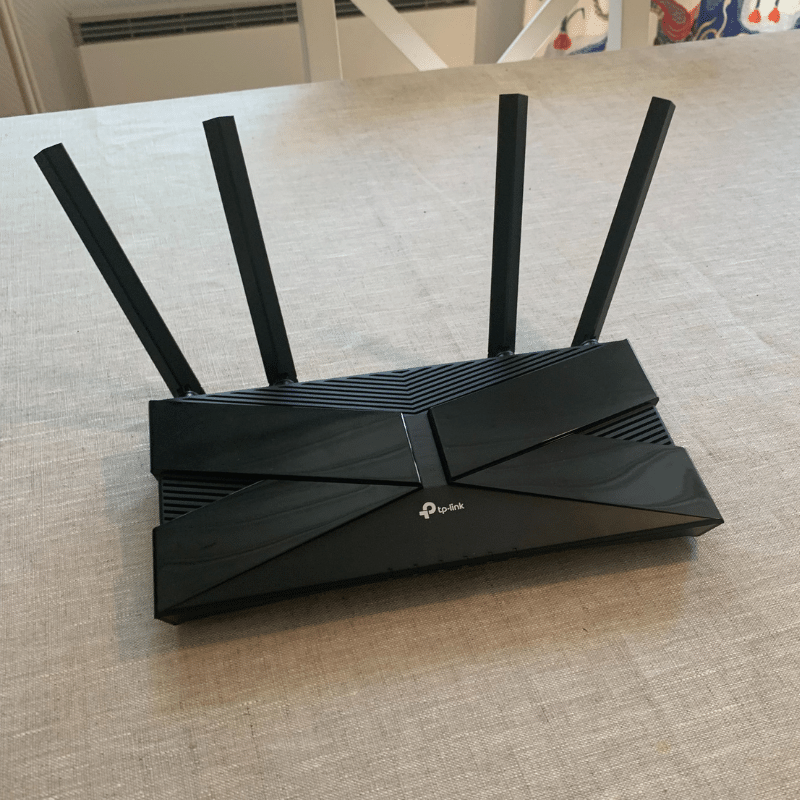
You’ll often find that the cheaper a router is, the slower its performance is and the lower its range is. But that does not appear to be the case with the Archer AX10!
Despite being one of the most affordable routers on the market, it comes up with the goods in terms of performance. We tested the download speed from 5ft away and it managed a pretty impressive 651.97 Mbps. That’s faster than a lot of other, more expensive routers.
In terms of range, things aren’t too bad at all. It manages 80-90ft. So, if you have a small to medium-sized house, this could be the one for you. Just be aware that if you want to extend the signal range of this router, you will need to use a traditional Wi-Fi extender as there is no support for OneMesh on the AX10.
But what features does it have? Well, you get a lifetime warranty and that’s pretty cool. Plus, there’s strong antivirus protection and a cool app to control other features (including Parental Controls) with.
So it seems like the AX10 packs quite the punch despite being of a low cost and small size. Let’s find out a little more.
Performance: 4.3
The main criteria most people are looking for from their router is performance, and often in relation to budget. And it’s this relationship that’s so inherently appealing about the AX10. You get a lot for your money!
The performance isn’t perfect as it’s lacking a 160 MHz channel. That would support better speeds for more devices on the network. But then again, the devices would need to support this channel bandwidth and a lot don’t as of yet. You won’t be missing a huge amount without this.
Time to break down the speed and range a little more.
Download speed
There’s no denying that the AX10 is pretty quick. We measured the download speed from 5ft away from the router and it came up with 651.97 Mbps on the 5 GHz band. Sure, you can get a lot faster than that but you’ll have to pay a premium!
Can you get a faster router for a lower price? Not really. You could get another 100 Mbps from ASUS (their RT-AX56U model managed a download speed of 754.02 Mbps in our test). However, that would cost you more money.
It really depends on what your home internet service plan is. If it’s capped at less than 600 Mbps, there’s not a huge amount of point going for a more expensive router than the AX10. That is, of course, unless you need a better range and features. More on those two aspects shortly.
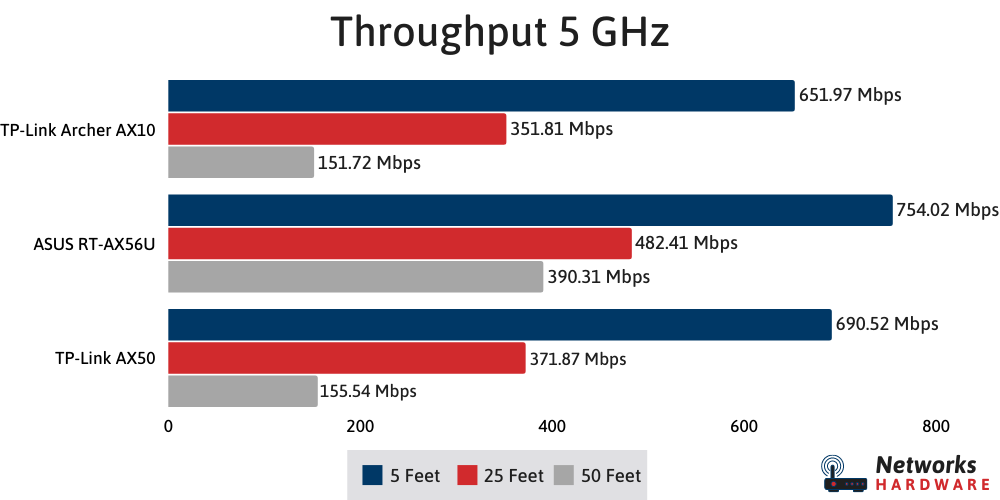
So what would you be able to do in theory with a download speed of 650 Mbps? Technically, as many as 26 simultaneous 4K Netflix streams if you so desired! The point is, this router will be enough for a large, high internet usage family when measured on speed alone.
We should also draw our attention to the 2.4 GHz band. Things aren’t quite as impressive here. 141.1 Mbps was the speed here and that ain’t so good. When compared to the 210.81 Mbps of the AX-56U it doesn’t look so strong at all.
When will this cause you an issue? If you have a large home with a lot of objects. 2.4 GHz is better at penetrating said objects and can have the result of a better range. Plus, some devices do not support 5 GHz.
Range
But does the range cut it? Just about. 80-90ft isn’t amazing but once again, it’s pretty impressive for the price. It’s enough for a small-medium sized home but probably won’t cut it for most workplaces.
Let’s compare that range once again to the ASUS RT-AX56U. Once again, the AX10 wins! We found that the ASUS offering could only manage 75-80ft. Believe us when we say that the extra 5-10ft really can go a long way. That’s an extra whole room in your house.
Remember, you can always use a Wi-Fi extender if you want to boost the range. Here are some of the best ones if you find yourself in that position.
Features: 4
Of course the AX10 isn’t going to be packed with features. But what you do get when you consider the budget of the router ain’t bad at all.
Tether app
Most of the functions of the AX10 are controlled by TP-Link’s Tether app. This is where you set up the router and it’s where you set the likes of QoS and Parental Controls.
We like this app. It looks good, it’s easy to use and it doesn’t overcomplicate things in the ways that a lot of router apps tend to. Nice design work from whoever put this together.
QoS
Short for Quality of Service, QoS is a feature that allows you to direct more performance from the router to specific devices on the network. All you have to do is go into the app, select the device and prioritize it.
What’s the point? More performance! If you’re about to embark on a gaming session and need as much ping as possible, this is the option for you. Also, if you’re about to download a large file, using QoS is likely to have that file downloaded quicker.
Parental Controls
Having control over the devices on your network doesn’t just stop at QoS. Parental Controls goes one step further, but with this feature it’s more about network security.
If you have other vulnerable internet users such as kids or elderly relatives in the house, you’re going to want to pay close attention here.
Parental Controls allow you to reign in the type of online content certain users on the network are able to access. Of course, this is great for the likes of casino gaming and adult content, but there’s one other benefit to it.
And that’s phishing. A lot of websites will prey on vulnerable users in order to obtain personal information or money. You can put a stop to that with Parental Controls.
TP-Link’s Parental Controls actually go one step further as you can restrict internet access at certain times of day. This is a great idea if you need your kids to dedicate some time to doing their homework or just playing outside rather than browsing YouTube and TikTok.
OFDMA, MU-MIMO and beamforming
Now for the more technical part of the AX10. But don’t worry. We’re about to break down these three technologies in detail so that you can know exactly how they will benefit you.
Let’s start with OFDMA and MU-MIMO as they come as a pair most of the time. While they are different technologies, they have similar benefits and that’s to do with performance. OFDMA and MU-MIMO both increase the time it takes to connect a device to the network and improve speed.
Another benefit of both OFDMA and MU-MIMO is that they actually allow the router to connect to more devices. If you have a large family, this could be essential. Many of us have lots of electronic devices these days, but with OFDMA and MU-MIMO, you minimize the risk of maxing out your router.
How does this work? Well, OFDMA assigns subsets of subcarriers to devices on the network. MU-MIMO assists this by focusing the Wi-Fi signal streams from the router to the devices in the first place.
And then there’s beamforming. Like MU-MIMO, this uses the combination of the Wi-Fi signals (or ‘beams’) from each of the router’s antennas to work more efficiently than individual signals and to direct them to specific devices. The result? Better range and speed for those specific devices!
Encryption
A router feature that is absolutely essential but often overlooked is security. If your router is insecure, it can compromise the security of the network as a whole. That includes all the devices connected to it!
There is a firewall to help with that. That should go some way to protecting your device from viruses. Plus, there’s three levels of encryption: WPA, WPA2 and WPA3. This improves the data security of your devices. Any of them!
What is missing?
One feature we always like to see from a router is Mesh integration. This would allow you to connect extra satellite nodes to your home network and be able to extend the range with seamless roaming. You won’t have to connect to a new network every time you need to move rooms.
We can let TP-Link off for missing this one out though. Mesh technology does cost a fair bit more and there aren’t any routers this cheap that support it.
You’ll just have to go with a traditional Wi-Fi repeater if you want to extend the range of your AX10. Here’s a look at the difference between that and Mesh.
There’s also something missing that we loved on the older brother of the AX10, the AX50, and that is HomeCare: a specific antivirus function of the router. That would certainly be one way to beef up your router security so if viruses are something that concern you then maybe this upgrade would be worth it.
Design: 4.4
If you like the idea of having an unobtrusive router then the AX10 could satisfy your needs. It’s small, it’s lightweight and it doesn’t look half bad.
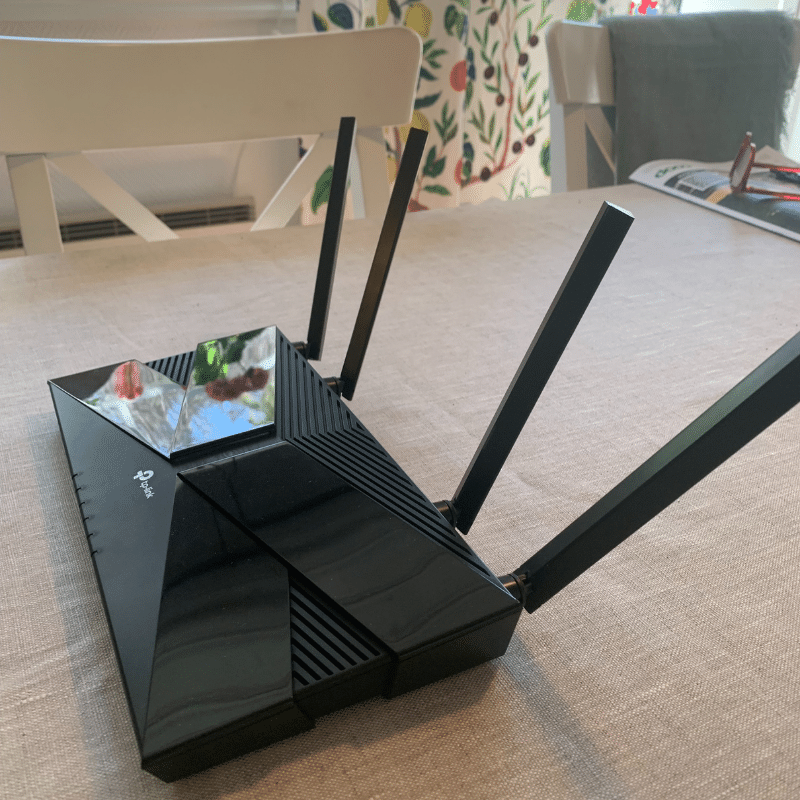
The AX10 is actually exactly the same size and weight as the AX50. But it’s smaller than the ASUS RT-AX56U which can only be a good thing.
One thing that the AX10 is, unfortunately, lacking is in USB ports (there aren’t any at all). That’s why we’ve docked a few points from it in this section. This means you won’t be able to connect any external hardware like a printer.
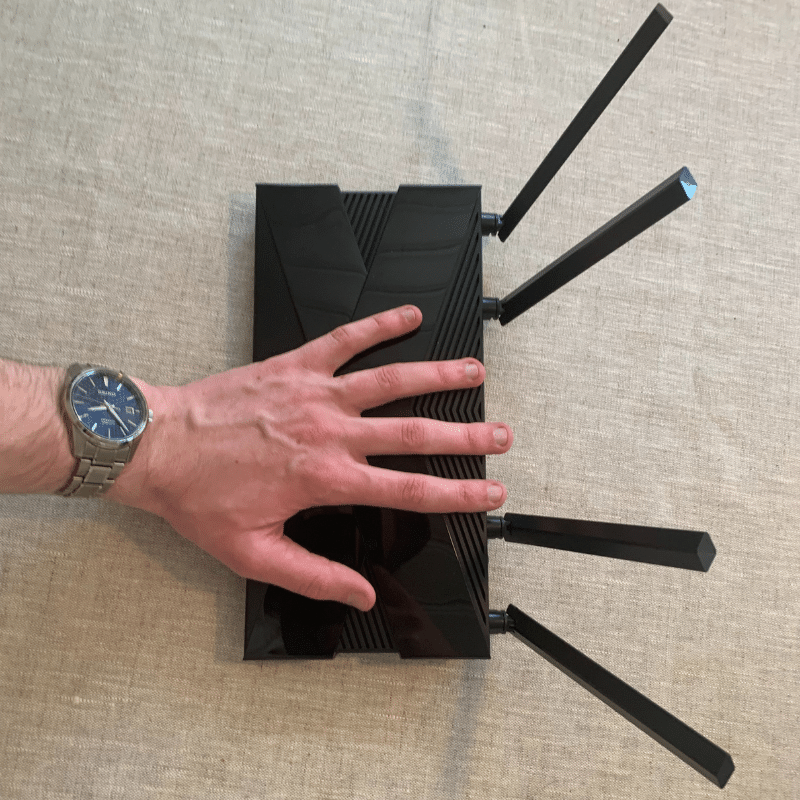
It does have LAN ports though. Four of them, no less. That’s about average for most routers that aren’t super high performance. And it’s all you should really need in any case.
LAN ports allow you to plug devices straight into the network provided that they have an Ethernet port and that you have an Ethernet cable. This removes the need for Wi-Fi, meaning there will be less resistance in the connection and that speeds will be a lot faster.
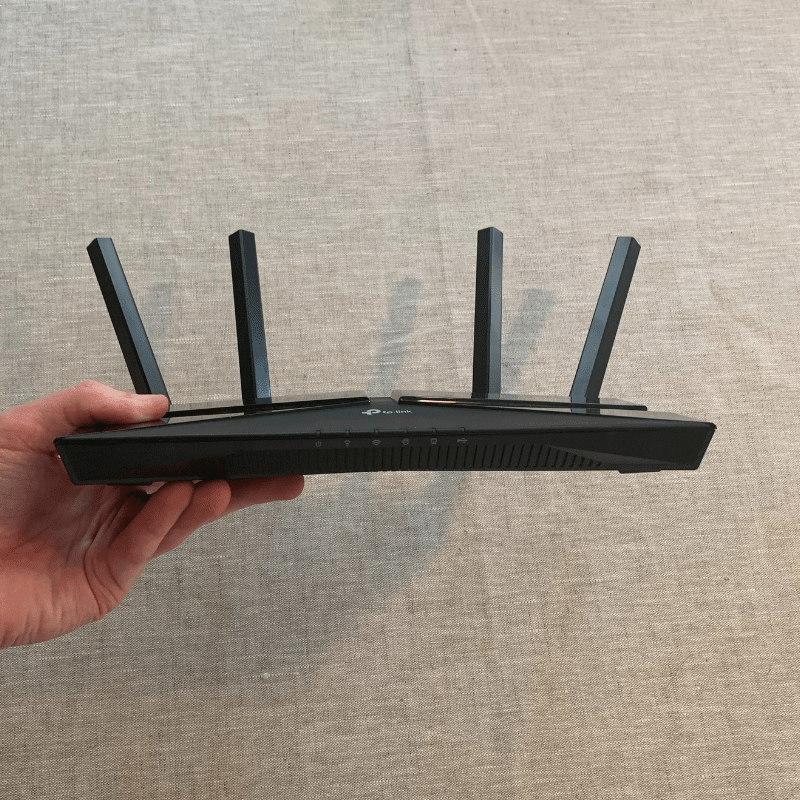
As standard, there’s also a Gigabit WAN port which you’ll need to connect your device to a modem in the first place.
Setup: 4.4
You can’t really fault the TP-Link AX10 setup process! It’s really easy thanks to the Tether app. In fact, the whole process should only take a couple of minutes, tops.
Once you’ve plugged the device into the mains and your modem, you just need to download the app from the App Store or Play Store. Then, connect to your router with Bluetooth. Follow the on-screen instructions from the app and you’re good to go.
There is another option. For those who don’t have a smartphone for whatever reason, you could always just enter 192.168.1.1 into your browser to set up the router. It does take a little longer, but the option’s there for those in the dark ages.
Value: 4.7
Here’s our favorite thing about the AX10 as a whole. The price! For a router to perform as well as this one does and have these features is one thing. But for it to do that while being a member of the under $100 club is pretty cool indeed.
Once again, let us draw your attention to the comparison between the AX10 and the ASUS RT-AX56U. The RT-AX56U is certainly not part of the under $100 club. In fact, it’s around double the price.
Sure, you get AiMesh with the RT-AX56U but is that enough for it to be worth the price in comparison to the AX10? Only you can decide that… It’s really down to personal opinion at that point!
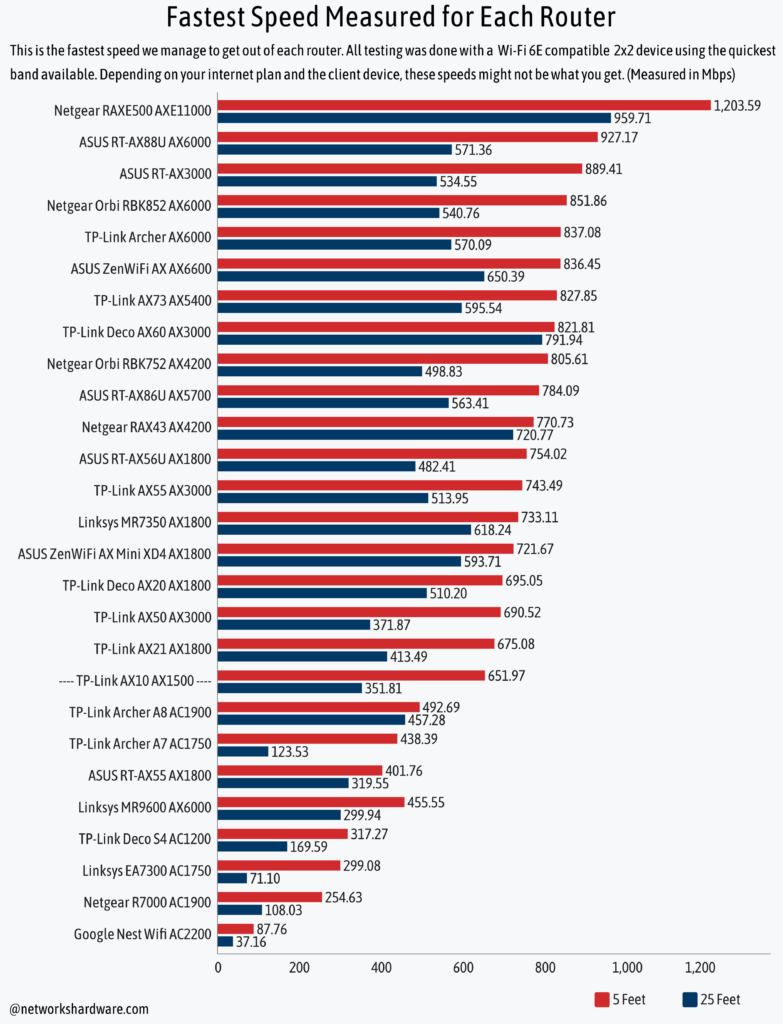
Views from Other Reviews
Join us as we take a look at what some other critics have had to say about the AX10. To our surprise, the opinions are a little more mixed than we would have thought. We really thought other reviewers would be all over this thing! But, we suppose it’s only fair that we let them have their say…
Everybody does seem to agree that this is about as good as the price gets for a Wi-Fi 6 router. Tick! But people seem pretty upset about the lack of antivirus technology. And we don’t blame them really.
Some critics have been quite dismissive of the AX10 because of the fact that there is no 160 MHz channel. But as we mentioned earlier on, that isn’t the end of the world. It doesn’t seem to affect performance too much.
In terms of performance, the reviewers seem to be pretty happy when it comes to the 5 GHz band. But they’re not quite as sold by the 2.4 GHz. That seems fair enough as well.
At the end of the day, the small niggles that reviewers have with this thing don’t make it a bad device. It’s still great value for money, and that’s one thing we can all agree on!
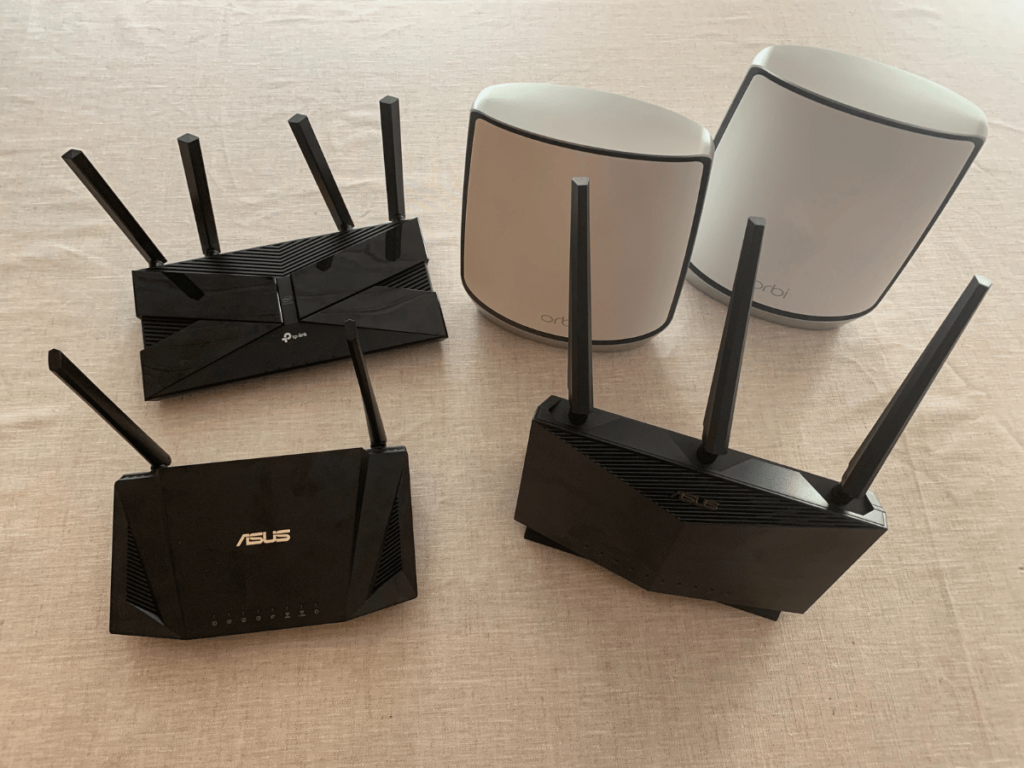
Different Options on the Market
Got a faster internet plan than 650 Mbps? What about a large house? Fancy a more responsive 2.4 GHz? Or on the flip side, do you have a small home and a low internet plan and want to save even more money?
These are all questions you will need to ask yourself before you buy the AX10! And if the answer is yes to any of them, we fully recommend that you check out the following options first.

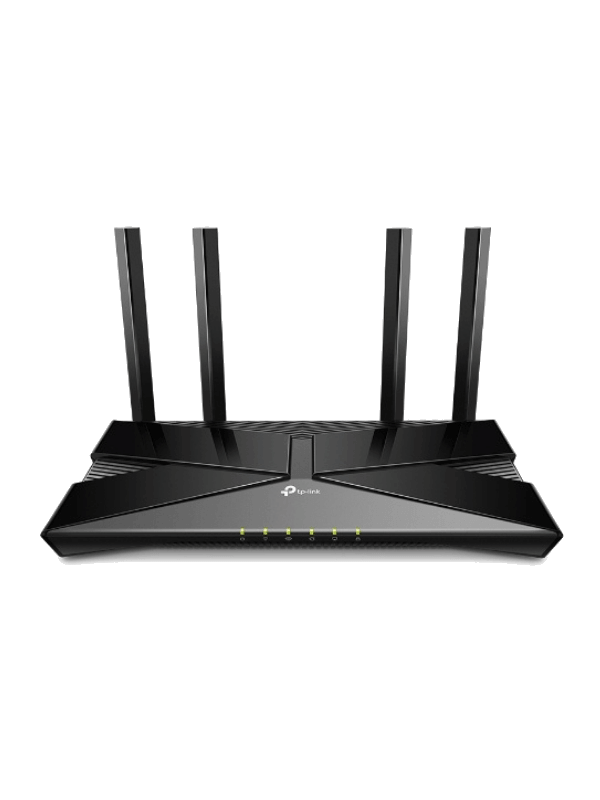

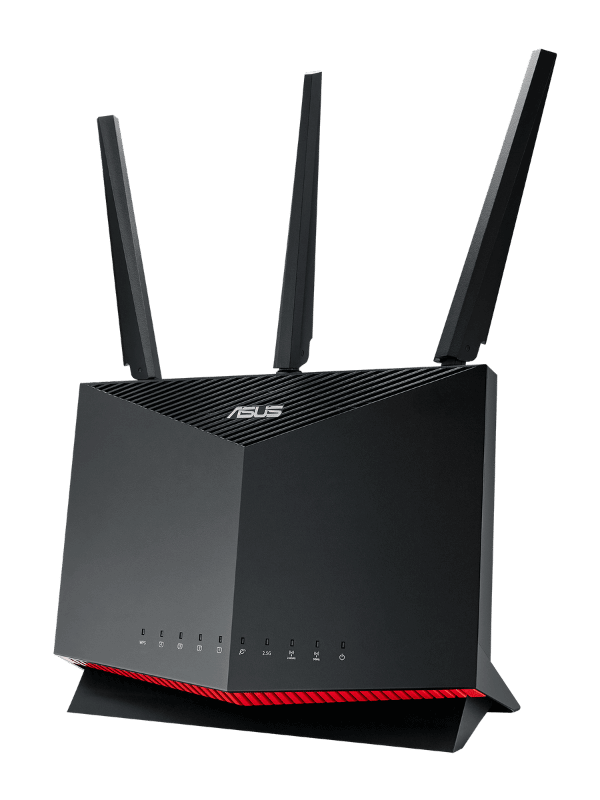
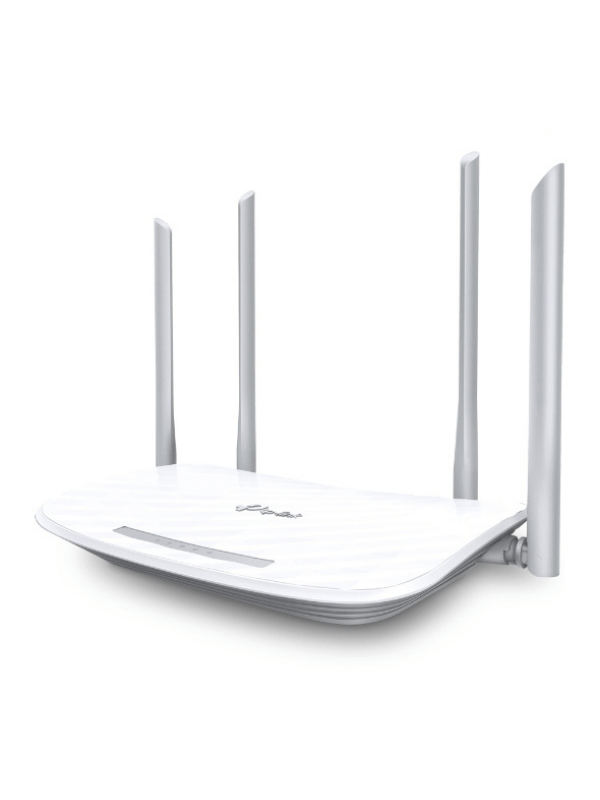
1 thought on “TP-Link Archer AX10 AX1500 Review”
Hi James and thank you for a well written review!.
I purchased this router in Dec. 2021 and it did not do the Mesh thing. But in April of 2022 TP Link did a Firmware update and included Mesh capabilities. Here is the current version I am running.
Firmware Version: 1.3.1 Build 20220401 Rel. 57404(5553)
Thank you
Doug